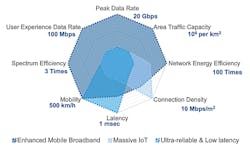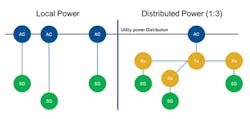Winning the 5G Marathon Requires the Right Strategies
Don’t Let Powering or Optical Connectivity Slow You Down —
The race to 5G is well under way. Network operators throughout the US and the world have made commitments to the deployment of 5G wireless technology. But the end is on the distant horizon. We need to look at this race as a series of relays, with each stage taking on a different set of objectives, timelines, and investment.
The first stage could be considered a sprint, in which today, many operators are close to the handoff point as they are incrementally upgrading from 4G to 5G. The final stage is a marathon.
In many cases, each stage brings on new spectrum, opportunities for new services, and stricter service level requirements.
Today, we are focusing on the last stage of deployment, the marathon run. In this stage, a healthy fiber diet is essential for meeting the 5G key performance indicators (KPIs), while planning for power is critical for a cost-effective and rapid deployment. Operators will begin to identify the broad 5G KPI categories noted in Figure 1 to participate and plan for those architectures to achieve the stated service levels.
Figure 1. Each of the 5G Key Performance Indicators are grouped into categories defining the use cases for 5G services.
As operators look to achieve the 5G KPI’s, new millimeter wave spectrum options are deployed. These spectrum options require operators to densify their mobile network utilizing much lower RF output power radios with inter-site distances less than 500 feet apart. By our estimates, US operators need to increase capacity by 10x over the next 10 years. To achieve these goals, the marathon stages will drive new optical infrastructure much deeper in the network and new challenges (such as powering small cells) will be a major obstacle for some.
Fiber Diets Help
The demand for broadband connectivity is no longer confined to the home or office. Consumers are looking to have a mobile-device experience similar to that of a wireline broadband connection. Examples are everywhere:
• live-streaming sports,
• 4k video upload and download,
• and the mobile office connected to the cloud.
Each of these applications place growing demand on the mobile network. As operators plan for this final marathon stage of their 5G deployment, they need to consider peak data rates of multigigabits and a user experience data rate of 100 Mbps to meet the 5G eMBB KPI.
To achieve these data rates, operators have 2 "knobs" they can turn in an orchestrated manner: spectrum and radio density. Historically, operators have turned to the simple approach of adding more spectrum to a tower to address bandwidth demands. However, over the past 10 years, the demand for bandwidth has pushed operators to the higher wavelength spectrum known as millimeter wave (mmWave). mmWave spectrum has been less desirable due to the losses and the requirement for line-of-sight communications, but this is the only part of the spectrum where vast (many hundreds of MHz) of spectrum are available.
Another challenge is that it is highly impacted by environmental factors such as rain, leaves, and fog. Therefore, to deploy mmWave spectrum, operators must densify their wireless network, bringing radios off the large towers and placing them along the street as small cells.
InvisiLight® Solution for Deploying Fiber
April 2, 2022Go to Market Faster. Speed up Network Deployment
April 2, 2022Episode 10: Fiber Optic Closure Specs Explained…
April 1, 2022Food for Thought from Our 2022 ICT Visionaries
April 1, 2022Hitting the Wall
As small cells are deployed and network capacity is increased, the transport of the wireless networks from the radio to the xRAN must be capable of the peak end-user experience data rates noted earlier. In order to address data rates in the marathon stage, operators require additional fiber optic infrastructure.
And while there is no power drink available to deliver immediate relief, providers can leverage the infrastructure they already have in place. Recent advances in WDM technology include lower-cost tunable transceivers and Bi-Di technology. In addition, the IEEE 50Gbps symmetrical standard supports next-generation PON technologies and can help them see the 5G finish line.
Another option is to leverage optical cable infrastructure. A significant part of deployment that drives most of the costs is associated with the civil works to provide connectivity. Recent advances in optical fiber and cable technologies provide operators with much denser optical connectivity that can be deployed in smaller ducts, vaults, and cabinets/closures. Cable manufacturers have adopted G.652 fibers with a 200 µm coating diameter. This innovation results in a 33% reduction in total cross-sectional area in the fiber. This allows for more optical fibers delivered in a cable for the same outer diameter or, for the same fiber count, the cable can be delivered with a lower outer diameter.
Powering to the Finish
Once operators have pushed through the wall, the finish line is on the horizon. However, electrical power is one of the remaining obstacles that must be addressed.
Historically, electric power was needed for each radio tower deployed every few miles. Fortunately, in cities across the US, small cells can access the electric grid via power sources along roads and sidewalks. That’s why small cells are often located on or near traffic lights, streetlamps, and transit stops. However, these access locations are not always aligned with the ideal location for providers’ small cell deployments.
We conducted a series of analyses on 5G small cell powering and found that a typical deployment of 20 square miles required approximately 590 5G radio sites when spaced with an inter-site distance of 500 feet. Normally, that would require a total of 590 individual local power grid taps for a single carrier. (See Figure 2.)
Figure 2. Operators have the choice of deploying local power for each small cell or distributed power which allows for one tap of the power grid distributed to several distributed small cells.
An alternative strategy operators can explore is using distributed power to the small cells. This means utilizing a single access to the grid, which can be transported along the optical infrastructure, in order to reduce the number of local power taps. Distributed power is not a new technology, and is deployed by many operators around the world. However, the challenge presented for small cell deployment today is the amount of power required. Today’s small cell radios require, in many cases, up to 400W per radio. Assuming a 2- or 3-sectored radio site, the power required could be as high as 1200W.
How do you deliver these power levels efficiently over a distributed environment safely?
Look to guidance from the standards bodies.
The Alliance for Telecommunications Industry Solutions (ATIS) (https://www.atis.org/) organization has stepped up in the development of a new power standard for "remotely powering distributed devices that consume more than the 100-Watt constraints." The development of this standard enables operators to leverage higher voltages such as 380V DC to deliver power levels required to support a single 5G small cell location in a touch-safe manner.
Bringing together new touch-safe power solutions with the optical infrastructure provides an opportunity for operators to reduce their dependency on the power utility through the reduction of local power taps.
Recently, Corning and EnerSys announced a partnership to help solve powering and deployment challenges operators face as they run the 5G marathon. Through our combined analysis, we have seen that a deployment using touch-safe power solutions can reduce local power taps by as much as 7.5 times — lessening the dependency upon the power utility.
Like this Article?
Subscribe to ISE magazine and start receiving your FREE monthly copy today!
Winning the Marathon
The deployment of 5G services by operators moves through a series of stages, with each stage focused on a series of key objectives to meet 5G’s KPIs. The final stage drives radio technology from the tower level to the street level, requiring new architectures and deployment methodologies.
Operators will look to new deployment methods to help mitigate the costs, speed up deployment and prepare for the next race heading toward 6G. Remember, this final stage is a marathon. Network providers must prepare and pace themselves, so when they come close to hitting the wall, they have the confidence to break through without a misstep.
About the Author







